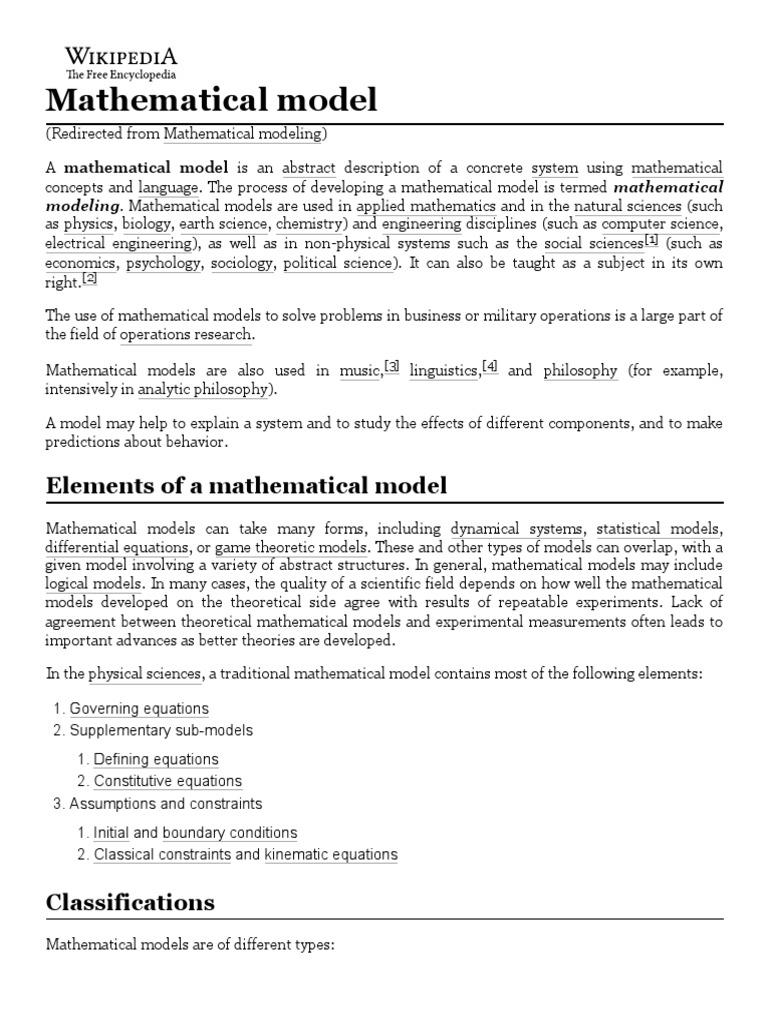The realm of mathematical modeling is a vast and intricate domain, often misunderstood and misrepresented. To consider a mathematical model merely as an equation is to significantly diminish its scope and influence. This article endeavors to unravel the complexities surrounding mathematical models and illuminate their significance beyond mere algebraic expressions.
At its core, a mathematical model is an abstraction of reality, a simplified representation of complex systems formed to achieve a purposeful understanding of phenomena. The essence of mathematical modeling lies not solely in equations but in the interrelationships, assumptions, and interpretations that they encapsulate. Thus, it is crucial to delve into the multifaceted nature of mathematical models, which encompass graphical, numerical, and indeed, qualitative aspects.
First, let us consider the definition of a mathematical model. Typically, a mathematical model comprises a set of equations and inequalities that describe a system’s behavior under certain conditions. However, this is merely the tip of the iceberg. Equations serve as the language in which the model is constructed, but they are derived from underlying principles, empirical data, and theoretical considerations. Therefore, a mathematical model is, at its foundation, an intellectual construct that bridges observations with theoretical frameworks.
To further elucidate this concept, one may think of a mathematical model as a lens through which to view reality. For instance, in the natural sciences, models are constructed to describe the motion of celestial bodies, the diffusion of substances, or the spread of diseases. Each of these models incorporates numerous variables, parameters, and boundary conditions that define their applicability. It is not simply their algebraic form that holds significance; it is the interplay of their components, guided by the underlying hypotheses, that renders them useful.
Equally significant is the role of assumptions in the construction of a mathematical model. Assumptions provide the framework for the model’s applicability and dictate its limitations. For example, in the modeling of population dynamics, one might assume constant birth and death rates. While this simplification renders the mathematical equations manageable, it simultaneously imposes constraints on the model’s realism. Striking a balance between simplicity and realism poses a considerable challenge and is critical in the modeling process.
Moreover, the methods employed to solve mathematical models vary significantly, and these methods often dictate the utility and insights derived from the model. Numerical simulations, for instance, can be paramount for tackling complex systems that are analytically intractable. In this context, mathematical models become computational constructs, evolving into algorithms used to predict outcomes over time. This transforms them from static equations into dynamic tools capable of responding to a plethora of initial conditions.
Another vital aspect deserving exploration is the concept of validation and verification of a mathematical model. A model must not only accurately reflect reality within defined parameters but must also be subjected to a rigorous process of testing against empirical data. Validation involves a multifaceted approach, examining whether the model’s predictions align with observed phenomena. Discrepancies may necessitate recalibration of the model or additional refinements to its assumptions. The iterative nature of this process highlights the dynamic relationship between mathematical modeling and the scientific method.
Innovations in technology have further expanded the horizons of mathematical modeling. Modern computational capabilities facilitate the treatment of large datasets, enabling the construction of models that were once unfathomable. The interplay between data-driven approaches and theoretical frameworks has fostered a new era of hybrid models, where machine learning techniques augment traditional mathematical methods. These multifarious advancements prompt intriguing questions regarding the nature of knowledge creation and understanding in an increasingly quantitative world.
The perception of mathematical models as mere equations often leads to a narrower appreciation of their capabilities and limitations. Models are fundamentally about the exploration of relationships. They provide insights into causality, guiding researchers in unearthing the underlying mechanisms governing systems. For instance, climate models extend beyond simple temperature equations to incorporate intricate feedback mechanisms, atmospheric dynamics, and oceanic processes, forging a comprehensive understanding of climatic shifts.
Consequently, one might ponder the philosophical implications of mathematical modeling. What does it mean to depict reality through mathematical abstractions? The epistemological landscape of mathematical modeling is rich with conjectures regarding the nature of truth and representation. In essence, these models invite us to reconsider our perceptions of knowledge, truth, and reality itself.
In conclusion, to view a mathematical model solely as an equation is to overlook the profundity of its conception and implications. Mathematical models are complex, adaptive frameworks that offer profound insights into the intricacies of the world. They are not merely tools for prediction but also instruments for enhancing understanding and facilitating discourse across disciplines. In this light, the exploration of mathematical modeling transcends traditional boundaries, engaging with the curiosity of scholars and practitioners alike. Ultimately, the journey into mathematical modeling encourages a profound shift in perspective—one that embraces complexity, fosters inquiry, and challenges the limitations of conventional thought.












